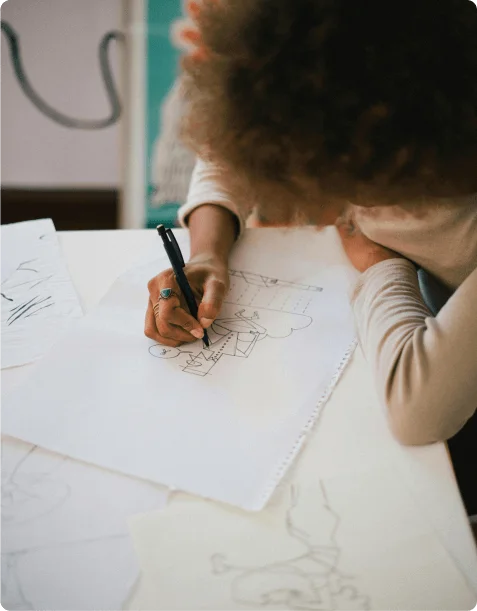Creative Art Therapy for Teens
Teenagers are often described as the most difficult population to counsel when it comes to mental health therapy. In traditional talk therapy, teens and adolescents frequently struggle to open up, express feelings, and/or process struggles. Plus, during the adolescent and teens years, individuals are experiencing a crucial period of development. Essentially, teenagers have some unique struggles, often necessitating innovative therapeutic interventions to assist them in the therapeutic process. This is where creative art therapies can often be a great fit for teenagers and adolescents. There are many different kinds of creative art therapies, and below, some of the most popular are outlined.

Music Therapy
Music therapy, an expressive art modality (and one of the oldest types of therapy) is an evidenced-based therapeutic intervention. Music therapy involves listening to, composing, dancing to, or singing to music. Music therapy can incorporate a variety of instruments and genres of music. Listening to music can provide teens (and anyone!) a relaxing and mindful experience. Music therapy is often a top choice for teens because:
- Most teens already love (and are actively listening to) some sort of music
- Music therapy is noninvasive/nonthreatening
- Music therapy allows the teen to go at his or her own pace (every teenager is unique)
- Music therapy can even be used outside the therapist’s office (i.e. – at home, school, etc.)
Important to note is that music therapy is about more than just the actual music. It is considered a therapeutic approach because of the therapist’s ability to facilitate your teen in making connections, finding deeper meanings, and learn things about him or herself.
Music therapy can be helpful in assisting your teen in:
- Identifying and recognizing thoughts and feelings
- Finding deeper meanings to his or her experience(s)
- Improving self-confidence and self-esteem
- Managing depression and anxiety
- Learning about themselves
- Promoting self-expression
- Managing stress
- Encouraging healthy coping skills
If your teenager shows any interest in music or instruments, music therapy may be a fantastic venue for him or her to express themselves, find increased peace, and gain many other therapeutic benefit(s).
Art Therapy
Art therapy, sometimes referred to as ‘expressive art therapy’, refers to the use of a variety of art mediums as a way of encouraging teens to communicate difficult feelings and thoughts.
Art therapy can benefit teens and adolescents by:
- Helping explore current struggles and associated feelings
- Enhancing self-awareness
- Increasing self-esteem
- Assisting in problem solving
- Relieving symptoms of stress, depression, and anxiety
Art therapy can take on so many different forms and utilize a wide range of mediums. The flexibility of art therapy tends to be perfect for teens and adolescents, as each person may connect to, and/or benefit from, varying approaches. Some popular mediums used in art therapy include:
- Paint – watercolors, oil pastels
- Paper – construction paper, tissue paper, newsprint, miscellaneous paper,
- Pencil/pen/crayon – colored pencils, ink pens, felt-tip pens, markers, crayons, etc.
- Collaging materials – old magazines, textured materials, different fabrics
- Clay – paper or firing clay
If your teen is interested in art of any kind, art therapy may be a great way for them to reap the benefits of therapy, without having to participate in traditional talk therapy.
Creative Writing
Creative writing is used by many therapists who work with teens and adolescents, as a way to verbalize feelings into written word. Writing can, often times, be a much more effective way to get teenagers to express themselves, compared to talking. For some, this is because it allows time to think about what he or she wants to express. For others, writing is more helpful, as talking involves another person’s reactions, responses, etc.
There are therapists who are specifically trained in creative writing therapy. If your teen sees a therapist who specializes in this approach, he or she may use one of the following approaches to therapeutic writing:
- Storytelling
- Narratives
- Journaling
- Poetry
- Dialoging
Creative writing is not only a great way for young adults to learn to express themselves, but can also aid in:
- Problem-solving
- Stress relief
- Making connections between thoughts and behaviors
Creative writing comes in many forms, as mentioned above, but some specific examples of using creative writing are:
- Writing a letter releasing anger, sadness, etc. to a specific person
- Writing about a specific theme, such a personal experience with depression, anxiety, low self-esteem, loneliness, etc.
- Journaling to track negative self-talk or unhealthy behaviors
Regardless of why your teen is in therapy, creative writing can be a fantastic outlet and a helpful venue of expression.
Drama Therapy
Drama therapy, sometimes referred to as psychodrama, is an experiential therapeutic approach to facilitating positive change. It specifically uses the theatre and/or drama processes to work through, and achieve, identified therapeutic goals. Drama therapy involves:
- Storytelling
- Improvisation
- Role play
Participating in drama therapy may include acting out specific interactions, practicing certain healthy behaviors, expanding on particular life roles, and exploring specific relationships.
While drama therapy can be used for any population, it is a popular choice when working with teens and adolescents. Drama therapy is adaptable, meaning it is easily modified to meet the developmental needs of teenagers. Drama therapy is also extremely engaging, which allows for teens to interact and be action-oriented in the therapeutic process. Essentially, teens will be able to get involved in the role play, and reap the therapeutic benefits, often without ever knowing they are actually engaged in therapy!




